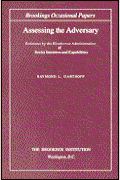Nearly 50 years ago, the country weathered a historical presidential transition in turbulent times, as John F. Kennedy bested Richard Nixon in the race to replace Eisenhower. Brookings played a behind-the-scenes role to help ease the transition.
“[Brookings] deserves a large share of the credit for history’s smoothest transfer of power between opposing parties.”
Theodore C. Sorensen, Special Counsel to John F. Kennedy
The 1960 race between Kennedy and Nixon came at a particularly delicate time. The Cold War was threatening to become a hot war and the nuclear arms race was intensifying.
With a grant from the Carnegie Foundation, Brookings’s then-president, Robert Calkins, gathered a discreet advisory group to help plan for a smooth transition, no matter who won the presidency. The 14 former government officials had all been presidential advisers. They included Brookings scholars and business executives from top American corporations, all with managerial talent and broad experience in domestic and foreign policy.
Eisenhower’s counsel, David W. Kendall, was key to establishing the Brookings transition project and bringing all sides to the table, and the White House sent cabinet secretary Brad Patterson to the table. Nixon sent Brigadier General Robert Cushman, Jr., and Kennedy sent Clark Clifford. It was a nonpartisan, cooperative effort of a scope difficult to imagine in today’s highly charged, partisan political environment.
Under the leadership of Brookings scholar George Graham, the group reviewed nine confidential memos to the president. The memos, drafted before the election, were not meant for publication and were never widely circulated. Candid, forthright assessments of the keys to a successful transition and the political pitfalls that abounded, the memos offered up historical analyses of the governing styles of presidents who had gone before, especially Roosevelt, Truman and Eisenhower. They offered frank advice to the incoming president about how to manipulate the levers of power, and how to deal with Congress and the news media to implement his policies and display leadership.
To judge from this passage in Calkins’ New York Times obituary, the project was a success:
The organization’s (Brookings) influence was evident when President John F. Kennedy took office in 1961. His Administration relied heavily on the institute’s briefing papers on many issues facing the nation. Theodore C. Sorensen, who was Kennedy’s special counsel, wrote that Brookings “deserves a large share of the credit for history’s smoothest transfer of power between opposing parties.”
The Brookings Institution is committed to quality, independence, and impact.
We are supported by a diverse array of funders. In line with our values and policies, each Brookings publication represents the sole views of its author(s).







Commentary
Eisenhower to Kennedy: Brookings and the 1960-61 Presidential Transition
November 5, 2008